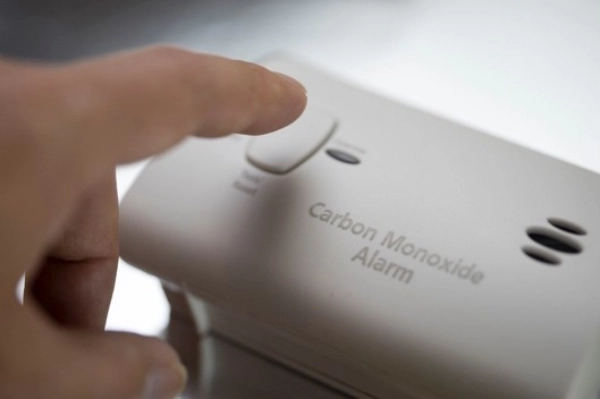
Carbon monoxide (CO) is an invisible, odorless gas. It is produced when fuels like gasoline, wood, coal, or natural gas are burned. Exposure to carbon monoxide can be dangerous to your health and can cause various symptoms to occur.
Symptoms of CO poisoning include:
- Headache
- Dizziness
- Weakness or fatigue
- Vomiting
- Chest pain
- Confusion
If you are exposed to CO for too long, it can cause you to pass out or even be fatal. If you're asleep, you may not experience symptoms before severe health effects set in. For these reasons, it is essential to know the possible sources of CO that exist in your home and to have working CO detectors throughout your space.
Protect Your Flagstaff or Camp Verde Home from Carbon Monoxide
At Aire Serv of North Central Arizona, we can assist you with the installation, replacement, and repair of carbon monoxide detectors. We'll outline some of the most common sources of carbon monoxide that you may have in your home, so you can be more aware of the risk factors and take extra care when necessary.
These are seven of the most common CO sources that you are likely to find in your home:
1. Faulty Furnace
One of the most common sources of carbon monoxide in the home is a faulty furnace. A malfunctioning furnace can leak CO into your indoor air, causing it to build up and create an unsafe living environment. To reduce the risk of being exposed to this toxic gas, it's important to inspect your furnace regularly for signs of wear or damage that could lead to leaks.
2. Gas Stoves or Ovens
Gas stoves and ovens are common kitchen appliances, but they can also be a source of carbon monoxide. If these appliances are not properly vented or maintained, they may leak dangerous levels of CO into your home. This is why it's important to regularly inspect gas stoves and ovens for signs of wear or damage and to make sure that the vents on these appliances are clear and unobstructed so that any CO produced can escape safely outside.
3. Water Heaters
Water heaters are a common source of carbon monoxide in the home. If not properly maintained, water heaters can leak dangerous levels of CO into your living environment. Regularly inspect your water heater for signs of wear or damage that could cause leaks. Also, ensure that the vents on the appliance are clear and unobstructed to prevent any produced CO from building up indoors.
4. Fireplaces or Wood-Burning Stoves
Fireplaces and wood-burning stoves are often seen as a cozy addition to any home, but they can also be sources of carbon monoxide (CO) if not properly maintained. Even when they are well-maintained, fireplaces and woodstoves can still produce large amounts of creosote — a substance that makes chimneys more likely to become clogged. This clogging can cause CO to back up into the home.
It's important to have your chimney professionally inspected and cleaned annually to reduce the amount of creosote buildup. You should also check for any gaps or cracks in the fireplace or stove that could allow gas to leak into your living space. Ensure the flue is open when you are burning wood or using the fireplace so that any produced CO can escape outside.
5. Portable Generators
Portable generators are often used to provide an emergency power source during blackouts and other unforeseen power outages. However, the combustion process inside the generator produces CO, which can be released into your indoor air if the generator is not vented correctly.
To reduce this risk, it is essential to make sure that any portable generator is located outdoors, at least 20 feet away from windows or doors, and to ensure that the venting system on the generator is clear and unobstructed.
6. Automobile Exhaust from Garages and Carports
Car exhaust can enter your home in a variety of ways. Exhaust from cars sitting in a garage or carport can seep into the home, especially if there are cracks or gaps in the walls or doors. Additionally, running a car inside a garage, even with the door open, can still cause CO levels to rise as it can mix with the air that is circulating through the space.
7. Tobacco Smoke
Tobacco smoke is a major source of carbon monoxide in the home, as it contains significantly higher levels of CO than other combustible materials. The tobacco smoke releases and disperses CO molecules into the air which can then enter your living space through open windows and doors, and even seep through cracks or gaps in walls. It's best to avoid smoking indoors for many reasons, including the risk of carbon monoxide.
Carbon Monoxide Detector Installation and Repair in Flagstaff, Camp Verde, and Beyond
At Aire Serv of North Central Arizona, we provide comprehensive services for carbon monoxide and smoke detectors. Our experienced technicians are trained in detecting sources of CO in your home and can assist with the installation, replacement, and repair of these important safety devices.
Exposure to carbon monoxide can be very dangerous, which is why we take extra care when servicing any CO detector in your home. We can help you decide on the type of detector that is right for your home, replace the batteries, and test the unit to ensure that it's functioning properly and that your family is protected.
Call us with any questions you may have about our Flagstaff and Camp Verde HVAC services. We look forward to assisting you!

